Protect Existing Book of Business and Drive Continuous Improvement
Business Process Improvement- The Basics #1
Welcome to Becoming a Leader Through Business Process Improvement. In this book, you will learn how to gain the skills and knowledge to make an organizational impact.
Business process improvement (BPI) is a strategic planning methodology to identify, analyze, and improve the operations or employee skills that could be optimized to encourage more efficient operations, lower cost, or higher overall business growth.
Today, complacency is one of the top challenges to organizations that weakens them like a disease. This complacency makes us blind to external threats and pressures. But, the good news, BPI is the cure for this disease. Creating an improvement mentality helps organizations establish the right mentality to succeed and reach new heights. One of the main objectives of continuous improvement strategies is to increase the skills and capabilities of all employees so they can effectively engage in problem-solving at work.
Take the Course: Leadership, Business Process Improvement, & Process Mapping!
Business Process Improvement (BPI) is a systematic approach to identifying and implementing improvements to how businesses operate.
BPI can be used to improve any aspect of a business, from customer service to product development. By streamlining processes and making them more efficient, businesses can save time and money and improve the quality of their products and services.
BPI is not a one-time event but an ongoing process that should be incorporated into the day-to-day operations of a business. By continually assessing and improving processes, businesses can stay ahead of the competition and keep their customers happy.
Table of Contents
-
Business Process Improvement- The Basics
-
What is Business Process Improvement?
-
Why Study Process Improvement?
-
Why does business process improvement matter?
-
Why start now with business process improvement?
-
How Do I Start Learning About Process Improvement?
-
Application of Six-Sigma methodologies in business process improvement
Business Process Improvement- The Basics
1.0
The introductory section will lay the conceptual framework and explain the design of this book. We will cover the fundamental concepts you must know and explain their what, how, and why.
First, let's start with some light humor by pointing out the cartoon you see here.
While this illustration may be a bit exaggerated, many of us have likely experienced being in the place of the cavemen pulling the wheel-less cart. We are all busy and sometimes don't see the improvements to make our lives much more manageable. We need to think about this cartoon from time to time to consider which role we play.
Being aware of this ability to have tunnel vision will challenge us to stop thinking about why we are doing something.

As you will see and learn, process analysis and redesign are what many find to be the fun part of a business. This is where we can take a break from the routine of our job and spend time working to make things better using our creative and problem-solving muscles. Learning this critical skill set will help you separate yourself from others and showcase your skills as one of the more valuable members of your team and company.
This article series will teach you how to solve work problems, making you the go-to process improvement pro.
Every person in every organization should have access to this material and knowledge to be more responsible for improvement. You do not need a specialist or consultant to fix your problems; you need a can-do attitude and the willingness to execute your strategy.
You will find that business process improvement is balance of influence, creativity, fundamental concepts, and business mastery. Let's get started!
What is Business Process Improvement?
2.0
Business Process Improvement (BPI) is a systematic approach to identifying and improving organizational procedures. BPI aims to increase efficiency, effectiveness, and customer satisfaction while reducing waste and costs.
There are many different business process improvement methods, but all share a common goal: to make the organization's procedures more effective and efficient. Some common methods of BPI include process mapping, process redesign, process improvement teams, and Six Sigma.
BPI is not a one-time event; it is an ongoing journey that requires commitment from all levels of the organization. When done correctly, BPI can significantly improve productivity, quality, and customer satisfaction.
Business Process Improvement or BPI is the art and science involved in change management.
2.1
Business Process Improvement (BPI) focuses on delivering value through improving quality, enhancing service, reducing costs, and/or increasing productivity of an existing activity or business process.
BPI is used to identify the need for change, analyze current processes, gain organizational support, create new processes, and eventually maintain those processes. But BPI is also more than that. BPI is a continuous improvement cycle that changes how you think and approaches your tasks.
The purpose of BPI is to continually improve process productivity with the desired results being produced consistently. BPI is used to ensure that a process uses the most efficient resources to produce an outcome at the expected minimum cost. We accomplish this by creating a system where our tasks always work as expected, are completed in the appointed time, and are maximized for effectiveness, efficiency, and quality.
BPI can be a term that ranges from incremental continuous improvement (CI) to complete overhaul to how things are done. This more dramatic shift in the operating procedure is known as business process re-engineering (BPR).

Why Study Process Improvement?
3.0
In any organization, business process improvement is a systematic approach to identifying opportunities to improve efficiencies and effectiveness of processes. BPI can be used to streamline internal operations or create better customer experiences. There are many benefits of implementing BPI, including:
1. Improved efficiency and productivity: By improving processes, you can eliminate bottlenecks and reduce waste. This can lead to increased efficiency and productivity throughout the organization.
2. Improved quality: By identifying and addressing process issues, you can improve the quality of your products or services. This can lead to increased customer satisfaction and loyalty.
3. Cost savings: Streamlining processes can lead to significant cost savings by reducing waste and increasing efficiency.
Your career will have a new speed.
· You will increase your career visibility,
· You will improve your technical and leadership skills, and
· You will become much more desirable to your employer and future employers
With increased value comes the ability to make more money. As you drive value by reducing process times and costs, that value will pass on to you.
Though business process improvement (BPI) is often associated with manufacturing and Six Sigma quality control initiatives, the reality is that any business can benefit from identifying ways to optimize their processes. Here are three key reasons your organization should consider conducting a BPI initiative.
First, by taking a close look at your organization's processes, you can identify areas of waste and inefficiency. This can lead to significant cost savings over time. In addition, improving processes can help improve customer satisfaction by ensuring that tasks are completed promptly and effectively.
Finally, BPI initiatives can also help to improve employee morale. When employees see that their company is committed to improving efficiency and eliminating waste, they often feel more motivated to do their best work. This can lead to improved productivity and increased profitability for the organization.
If you manage or own a business, process improvement should be significant to you. By improving processes within your company, you can increase efficiency and effectiveness, improve quality, and reduce costs. Implementing process improvements can also help to create a competitive advantage for your business.
There are many different ways to improve processes within a company. One popular method is Six Sigma, which uses a data-driven approach to identify and eliminate defects. Other methods include lean manufacturing and just-in-time production.
No matter what method you choose, the goal of process improvement is always the same: to increase efficiency and effectiveness while reducing costs. If you're not already implementing process improvements in your business, now is the time to start!
Why does business process improvement matter?
4.0
Business Process Improvement (BPI) is a systematic approach to identifying and implementing improvements to how businesses operate. BPI can be used to improve any aspect of business operations, from customer service to manufacturing.
There are many reasons why businesses should care about BPI. Perhaps the most important reason is that BPI can increase efficiency and effectiveness in business operations. By streamlining processes and eliminating waste, businesses can save time and money. In addition, BPI can also improve employee morale by making work more efficient and satisfying. Finally, BPI can help businesses gain a competitive edge by improving quality and speed of delivery.
In short, many good reasons for businesses to care about BPI. Implementing even a few simple improvements can have a big impact on the bottom line.
You will want to undertake business process improvements to deliver any of these possible results shown below. BPI is a must-have skill if you're going to:
· Enhance customer experiences,
· Increase productivity and efficiency,
· Increase capacity from the existing footprint,
· Improve customer service and teamwork,
· Reduce rework and over-processing,
· Improve internal and external communications, or
· Standardized end-to-end business processes.
Remember that this is only a short list of possible achievements.
For businesses, process improvement is essential to staying competitive and ensuring long-term success. In today's fast-paced business environment, companies must constantly strive to find ways to improve their operations. By streamlining processes and making them more efficient, businesses can save time and money while improving quality.
BPI can be used to improve any type of business process, from manufacturing and logistics to customer service and human resources. Implementing BPI can be challenging, but the rewards are well worth the effort.

Why start now with business process improvement?
5.0
You might be thinking, Why Now? Why not learn process improvements tomorrow?
Today, we live in an exciting time where our opportunities increase exponentially due to technology. We can now leverage these new technologies and apply them to areas never thought possible. Those trained to see and act on the opportunity will reap the benefits.
When done correctly and with the proper support, best-in-class processes can become a strategic advantage for a company in the marketplace. We can create an environment where costs are low as possible, operations are efficient as possible, and we have answers to our critical questions in the shortest time possible.
Flexible firms that embrace BPI thrive while their competitors struggle through the mess of processes, people, and systems.
When it comes to business process improvement, there are many reasons to start now. First and foremost, businesses are always looking for ways to optimize their operations and improve efficiency. By starting now, you can get ahead of the competition and implement best practices that will give your company a leg up.
In addition, business process improvement can help you save time and money. Streamlining your processes can eliminate waste and inefficiencies that cost your company money. Implementing improvements now can help you reduce costs and improve your bottom line.
Finally, business process improvement can help you improve customer satisfaction. By making your processes more efficient and effective, you can deliver a better customer experience that keeps them returning. Starting now can help you build a loyal customer base that will support your business for years.

How Do I Start Learning About Process Improvement?
6.0
How do you become a process improvement pro, and which skills are required?
-
1. Many businesses find themselves in need of process improvement but aren't sure where to start. Learning about process improvement can seem daunting, but it doesn't have to be. Here are a few ideas to get you started on your journey to improved business processes.
-
2. One of the best ways to learn about process improvement is to read about it. Many great books and articles on the topic can give you a solid foundation in the basics of process improvement. You can also find helpful information online, through websites and forums dedicated to the topic.
-
3. Once you've done some reading and have a basic understanding of process improvement, you can start trying some techniques yourself. Experiment with different methods and see what works best for your business. Document your results so you can track your progress over time.
The good news is that you do not need specific education or career path to succeed in BPI. Ideally, you should have a bachelor's degree in accounting, finance, or business. However, any bachelor's degree will serve you well.
If you have an MBA, you will have a broader understanding of business, which will benefit you. However, if you have not completed either of these degrees, don't worry. The many excellent online resources pick up much of what you need to learn.
Whether it be Udemy, online blogs, YouTube, or internet research, you can always find the information you need if you are dedicated to improving your life.
If you want to learn about business process improvement, you can do a few things. First, read articles and books on the topic. There are many resources available that can help you understand the basics of process improvement.
-
Attend seminars and workshops. These events can provide you with valuable information and insights from experienced professionals.
-
Join a professional organization dedicated to business process improvement. This will give you access to resources and networking opportunities.
Finally, real-life and personal experiences are among your most valuable assets. These hard-learned lessons are not found in any textbook and can help you overcome rookie mistakes and misconceptions.

Personal preparation in business process improvement
7.0
BPI can provide significant benefits to organizations in terms of increased efficiency and effectiveness, cost savings, and improved customer satisfaction. However, achieving these benefits requires careful planning and execution. This article provides an overview of the key steps in preparing for a BPI initiative.
The first step is to assess the organization's readiness for BPI. This assessment should include an evaluation of the organization's culture, structure, systems, and resources. Once the readiness assessment is complete, a BPI team should be assembled. The team should be composed of representatives from all affected departments or functions.
If you want to learn about business process improvement, you can do a few things. First, read articles and books on the topic. There are many ways to improve business processes, so it is essential to learn about as many of them as possible.
Second, attend workshops and seminars on the topic. These events can provide valuable information on how to improve business processes. They can also be a great networking opportunity, allowing you to meet other professionals interested in the same topic.
Finally, consider taking a course on business process improvement. This will allow you to learn about the topic in-depth and earn a credential to help you advance your career.
The personal preparation for learning and setting goals will significantly impact your ability to act from this book.
Preparing would help if you had goals broken into three short, mid, and long-term segments. Each step should be SMART, meaning they should have:
· Specific objectives –where you target a particular area for improvement.,
· Measurable –where you quantify or at least suggest an indicator of progress,
· Assignable – where you specify who will do it,
· Realistic – where you state the results that can be achieved realistically, given available resources, and
· Time-related – where you specify when the result(s) can be achieved.
In addition, you should adopt a mindset where you learn to seek and love gathering knowledge. You should develop habits that lead you to look for new challenges and opportunities and be resilient to battle your setbacks with vigor. It would help if you opened your mind to new ideas and possibilities.
My advice is not to be afraid to spend time researching unfamiliar topics and learning about new avenues that may interest you. If you pull an exciting thread, pull it, follow it, and see where it leads.
Furthermore, you should read often. There are so many great books out there that can help stretch your problem-solving muscles that are both fictional and non-fictional. If you have the time available, seek to read the biographies of top corporate cultural leaders today. You can learn from their mistakes and successes to your benefit by reading.
Read from the top business resources. The Harvard Business Review, The Economist, and Fast Company are all great resources.
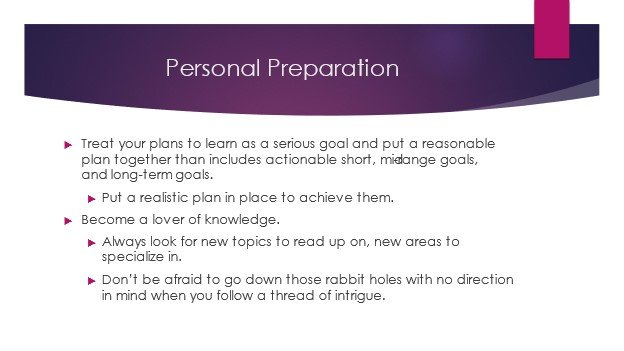
Test the waters for business process improvement
8.0
To gain a foothold in Business Process Improvement, you should also find opportunities to gain experience in creating a system that works for you. One of the easiest things you can do is create a list of possible processes that could benefit from being analyzed and then ask a friend or co-worker for their thoughts.
If you both agree, then you have a great idea on hand. If the idea is determined to be too large or opaque, then start somewhere else.
-
If you're looking to improve your business processes, it's crucial first to test the waters. See what areas need improvement and then focus on those specific areas.
-
You can easily see which business processes need improvement by testing the waters. This will help you save time and money in the long run by fixing only what needs to be fixed.
-
When it comes to business process improvement, always remember to test the waters first. This way, you can ensure that you're making the best possible decisions for your company.
Many businesses don't realize how much they can improve their processes until they take the time to assess where they're currently at. By testing the waters, businesses can start to see where improvements can be made and what benefits they could experience by making those changes. There are a few key areas that business process improvement can focus on, including efficiency, cost savings, and customer satisfaction. By closely examining these areas, businesses can see where changes could make the biggest impact.
3. Testing the waters for business process improvement doesn't have to be a huge undertaking - even small changes can make a big difference. By taking the time to assess current processes and identify areas for improvement, businesses can set themselves up for success in the future.
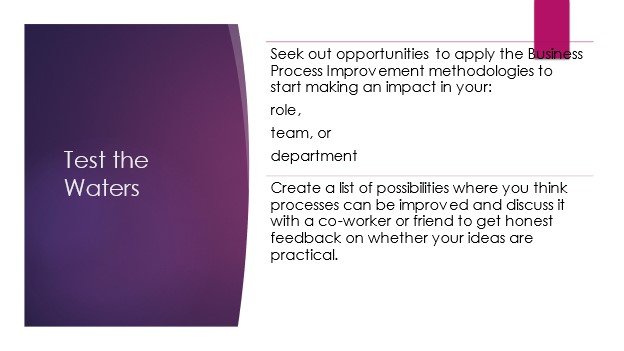
Establish yourself in business process improvement
9.0
If you want to establish yourself as a business process improvement specialist, there are a few things you can do to set yourself apart from the crowd. Establishing yourself and developing a reputation as a process improvement specialist is also essential. After you do this, others will have more confidence in your ability to complete projects competently and seek you out.
There are several ways that you can do to establish yourself outside of your day job. These opportunities can include free work for a local organization and becoming an active participant in online forums. You will find that your clients receiving pro-bono work will be more forgiving than paid gigs if errors result and a second pass or more time is required to complete the work.
First, focus on understanding the various methods and tools used in business process improvement. There is no one-size-fits-all approach to improving business processes, so the more knowledgeable you are about the options available, the better you will be to help your clients find the right solution for their needs.
Second, don't be afraid to get creative when finding ways to improve business processes. There is always room for improvement, so thinking outside the box is essential if you want to make a real difference for your clients.
Finally, remember that effective communication is key when working in business process improvement.

How Does a Process Improvement Initiative Benefit an Organization?
10.0
As you may well know, there are many benefits that process improvements will yield to an organization that is both tangible and intangible. Organizations must be aware of both the tangible and intangible benefits in explaining the impact of process improvements.
Tangible benefits are things that can be seen and measured. For that reason, they are often a priority of management. Tangible benefits include reduced operating costs, higher revenues, and improved compliance with regulations.
Intangible benefits are more difficult to measure, but items in this category impact an organization's image and reputation. A few intangible benefits of process improvement include a decreased level of errors, a higher level of trust between internal teams, and time savings.
Organizations that have adopted business process improvement initiatives have seen several benefits. Perhaps most importantly, these initiatives lead to better processes and improved quality for the organization. By improving efficiency and effectiveness, businesses can improve their bottom line and become more competitive in their respective markets.
In addition, business process improvement initiatives often lead to increased employee satisfaction. When employees are allowed to be involved in improving their work processes, they feel a sense of ownership and pride in their work. This can lead to increased motivation and morale, which are essential for any successful organization.
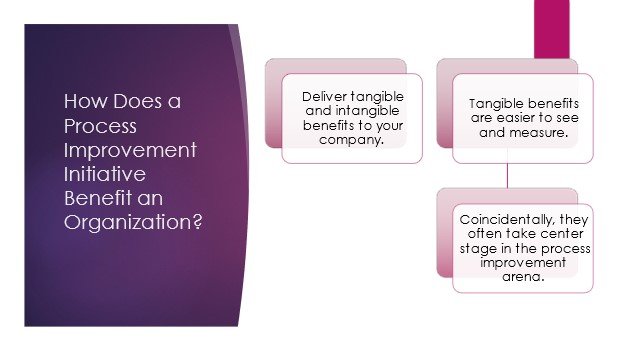
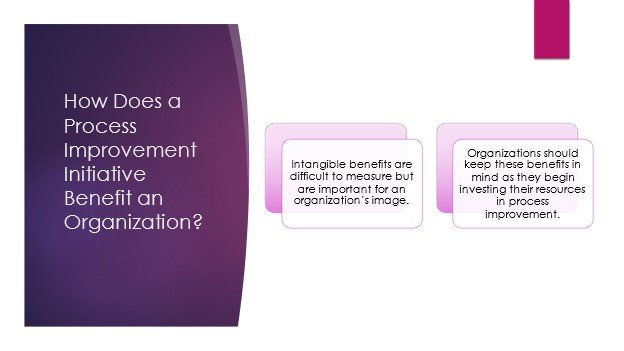
Application of Six-Sigma methodologies in business process improvement
11.0
The Six Sigma methodology is a business process improvement approach that can be used to streamline operations and reduce waste. This methodology emphasizes the importance of quality control and data-driven decision-making to identify and correct errors in business processes. By applying Six Sigma techniques, businesses can improve efficiency, reduce costs, and improve customer satisfaction.
One tool that is among the most critical is understanding DMAIC. There are five phases of the acronym DMAIC which stand for Define, Measure, Analyze, Improve, and Control. Each step is equally vital for Six Sigma projects and will be explained in greater detail later in this book. For now, remember that DMAIC is a continuous improvement cycle methodology.
The Six Sigma methodology is a well-known and popular business process improvement technique. However, many organizations are unaware of how to apply Six-Sigma to achieve the desired results properly. This article will explore the proper application of Six Sigma methodologies in business process improvement.
Organizations seeking to improve their business processes should first understand the basics of Six Sigma. Six Sigma is a data-driven approach that seeks to identify and eliminate errors in a process. The goal is to reduce variation in a process to produce consistent results within specified limits.
Organizations must first identify which processes need improvement to apply Six Sigma properly. Once these processes have been identified, data must be collected and analyzed to identify areas of opportunity for improvement.
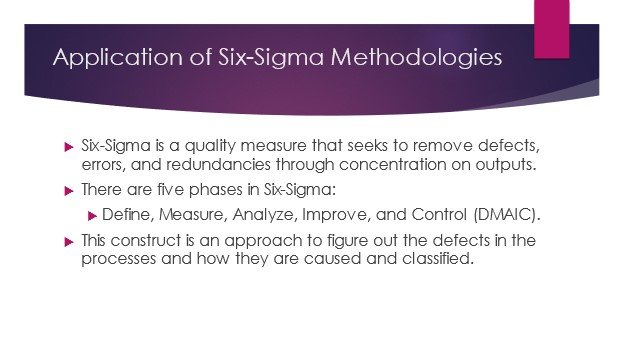
Who am I to write about business process improvement?
12.0
I have over 10 years of experience working in organizations, driving process improvements as part of my job. In addition to experience, I have also researched the best improvement models and adapted them for this book.
I have a passion for learning and sharing my knowledge with others, making creating resources like this fun and rewarding.
I am not a world-renown expert in business process improvement. However, I have seen firsthand how important it is to get things done efficiently and effectively. In my experience, the biggest obstacle to business process improvement is usually resistance from employees who are comfortable with the status quo.
I think anyone can improve their business processes if they are willing to put in the effort. Many resources are available to help you learn about best practices and how to implement them. The most important thing is to have a clear vision of what you want to achieve and then take small steps to get there.
If you're interested in improving your business processes, I encourage you to research and try some new methods. You may be surprised at how much of a difference it can make in your productivity and bottom line.
If you're passionate about improving things, business process improvement is a great field to get into. Here's why:
1. You can make a real difference in people's lives.
2. You can help businesses run more efficiently and save money.
3. It's a challenging and ever-changing field that keeps you on your toes.
4. There's always room for improvement, so you can never get bored.
5. You get to see the impact of your work firsthand.
6. It's a skillset that is transferable to many different industries.
7. You can be both creative and analytical in your approach.
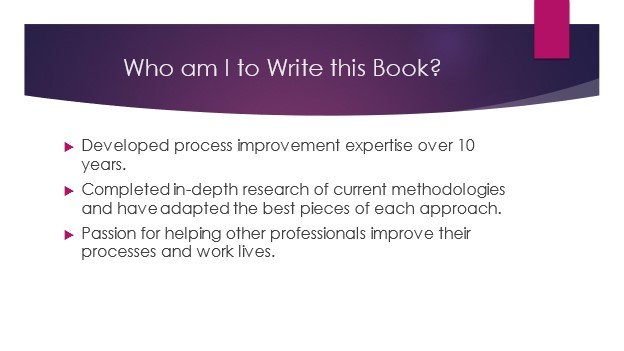
norrisdescuseence.blogspot.com
Source: https://benjaminwann.com/blog/becoming-a-leader-through-business-process-improvement
0 Response to "Protect Existing Book of Business and Drive Continuous Improvement"
Post a Comment